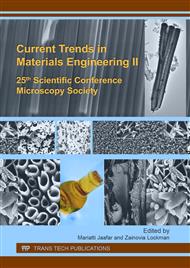p.140
p.144
p.148
p.152
p.156
p.160
p.165
p.169
p.173
Acidolysis Effect on Starch in Polylactic Acid (PLA)/Thermoplastic Starch (TPS) Blend
Abstract:
In this research, the Thermoplastic Starch (TPS) is blended with Polylactic Acid (PLA). By treating TPS with CA, the interfacial adhesion of PLA/TPS blend was also being improved. The ratio between PLA/TPS was chosen at 60/40 and 40/60 and CA contents were varied from 0%, 3%, and 6%. After acidolysis of TPS by CA, the tensile strength (60/40) and (40/60) of the PLA/TPS blend were found to increase. However, the elongation at break of PLA/TPS (60/40) blend was lower compared to PLA/TPS (40/60) blend. Higher loadings of TPS in the blend tend to make the blend elongate due to the flexibility of TPS after CA modification. On the other hand, by modifying the TPS with CA, the surface tension at the PLS/TPS interface had been reduced. This can be seen through micrograph that obtained from scanning electron microscopy. Different CA content in PLA/TPS blend showed the dispersed or co-continuous structure, which were related with the mechanical properties.
Info:
Periodical:
Pages:
156-159
Citation:
Online since:
September 2017
Authors:
Price:
Сopyright:
© 2017 Trans Tech Publications Ltd. All Rights Reserved
Share:
Citation:


